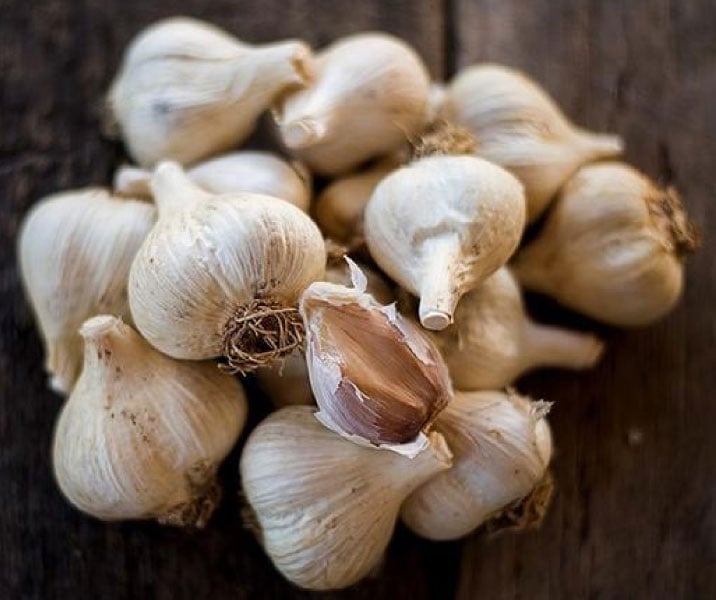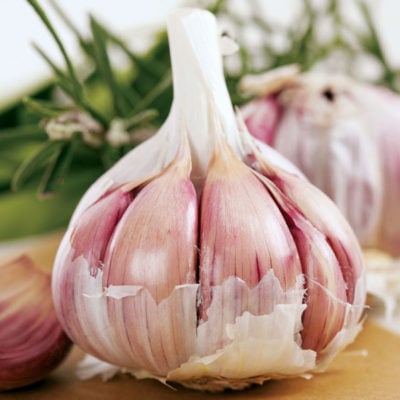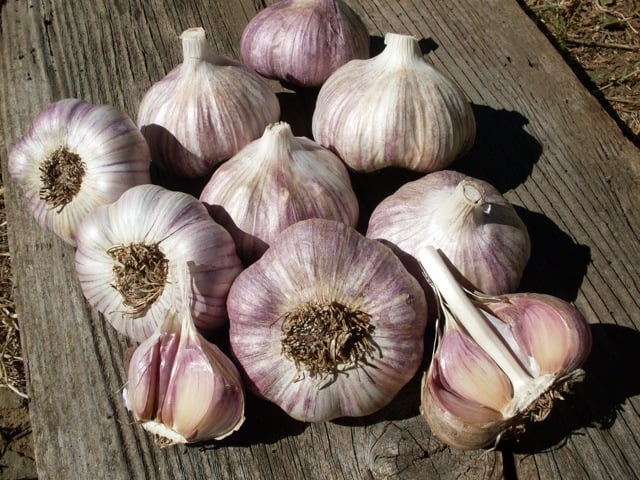
Learning Download: How to Grow Garlic
From Seed to Harvest: A guide to growing garlic.
Garlic cloves are used to add flavor to many dishes and carry plenty of health benefits. Garlic naturally repels pests from the garden and can be used for its bulbs or the scapes, or green green fronds, the bulbs produce. Scapes can be eaten fresh or used in various dishes.
To plant:
Garlic can be planted in the fall up to six weeks before the first hard frost. Though fall planting is recommended, garlic also can be planted int the spring as soon as the ground can be worked. Garlic is suggested to be grown from the bulb, where the cloves are broken apart from the bulb and planted with the pointed end facing up. However, garlic also can be planted from seed though it is much easier to grow from cloves and is rarely ever grown from seed. If planting the cloves, never use cloves from the grocery store. Plant the cloves 2 inches deep and 4 inches apart.
To grow:
Garlic repels pests from the garden, so it doesn’t have much trouble with them. If planted in the fall, mulch the garlic heavily with straw for overwintering. Remove the mulch in the spring after the last frost. Water every three days once bulbing begins, typically around mid-May. Weed frequently in the spring.
To harvest:
Garlic can take up to 210 days to mature. Harvesting depends on the climate, and garlic is ready for harvest when its tops are yellowing and falling over, but before they completely dry out. In northern climates, fall planting will lead to a harvest in July. In southern climates, it depends on the planting time.
Make sure the bulb wrapper has not disintegrated, and carefully lift the bulbs with a spade or fork. Brush off the soil and let the plants cure in an airy spot for two weeks. You can hang them upside down with a string to cure. The bulbs are cured and ready for storage when the wrappers have a paper-like consistency. The root crown should be hard and dry.
Garlic scapes are ready to harvest as soon as the emerge from the soil, when they are tender enough to eat fresh. As the scapes grow longer, they become tougher. Snip with shears to harvest the scapes without harmer the bulb.
What garlic craves:
Since garlic has such a long growing season, it is a heavy feeder. Upon planting, fertilize with compost, then continue to fertilize the garlic plants in the spring if they were planted in the fall. Fertilize with a side dressing or spread the fertilizer over the entire bed. To side dress the fertilizer, work the fertilizer into the soil about 3 inches from the plant. Garlic requires adequate nitrogen, so fertilize accordingly. Blood meal is a good source of high-nitrogen fertilizer. Once you begin fertilization, fertilize the garlic every three weeks.
Where to buy garlic bulbs:
You can find a large collection of different garlic varieties at Urban Farmer.
Learning Download: common pests and diseases: garlic
Common pests and diseases: Garlic
When growing vegetables, it is always exciting to care for the plant throughout its growing phase and then harvest it for delicious recipes later on, but one thing to watch out for is pests and diseases. Different plants are susceptible to different types of pests and diseases, and it is important to make yourself aware so you can keep a watchful eye and also take any preventative methods to keep your plants safe throughout their lifespan.
Garlic can fall victim to several different pests and diseases.
Pests:
Some of the common pests affecting garlic include bulb mites, leafminers, thrips and nematodes.
Bulb mites will stunt the plant’s growth and bulbs can rot in the ground or even when they are in storage. The mite looks like a pearl with legs. If they damage the plant, it can allow another invasion from other pests. Practice crop rotation, and treat garlic seed cloves with hot water before planting.
Leafminers can create white splotches on the leaves and the leaves will fall off the plant. If the leafminers infect the plant when it is young, it can reduce its yield. Remove plant debris from the soil immediately after harvest to prevent this, and use insecticides once the damage is identified.
Thrips will create discolored leaves and scarring, and affected garlic plants may look silver in color. To prevent his, don’t plant garlic or onion-related plants near grain fields. Overhead watering may help reduce the thrips. Apply insecticides once you identify the damage as that of a thrip.
Nematodes cause the plant to be stunted in growth and the root system won’t have fine roots. There also could be irregular lesions on the roots. Use hot water dips to control the nematodes in the bulbs, because crop rotation will not be very effective since nematodes have an extensive host range.
Diseases:
Some common diseases garlic plants experience include downy mildew, purple blotch, rust and white rot.
Downy mildew will create pale spots on leaves and a fuzzy growth on the surface of the leaves. Leaves turn pale and then collapse. Apply fungicide to treat and plant in well-draining areas.
Purple blotch will create water-soaked lesions on the leaves and stalks. Once they enlarge, they can become purple in color. Infected foliage may die. Practice crop rotation and reduce leaf wetness.
Rust will create white flecks on the leaves and stems, and if the infection becomes severe enough, it can cause the leaves to die. This disease prefers high humidity and low rainfall. The wind can transport the spores far distances. Plant in well-drained soil and control weeds, use a fungicide if necessary.
White rot will cause older leaves to yellow and stunt the leave’s growth. All leaves will then die, and a white growth will appear on the bulb’s base. This disease can survive up to 20 years and can cause major crop loss. Treat seeds with hot water before planting, use crop rotation and apply fungicides if available.
Learning Download: How to Cultivate the Best Soil for Garlic
How to cultivate the best soil for garlic:
Some people may be content with buying their garlic from a grocery store, since it is a relatively cheap vegetable and is usually in abundance. At the grocery store, it also is sold in different varieties, such as minced, cloves and garlic powder. However, gardeners are of a different breed and likely wish to grow their own garlic at home. If you have grown garlic, you know it doesn’t grow well in typical, fertile, rich soil like many other vegetables do.
What kind of soil does garlic need?
Garlic grows best in a well-drained sandy loam soil. Depending on the area in which you are growing your garlic, your soil may be too rich, or maybe it has more of a clay consistency. Too much clay will cause the soil to cling to the bulbs, which is difficult to remove upon harvest and may even stain the garlic wrapper. Also, clay soil holds more water than sandy, loamy soil does, and the garlic will rot if it sits in standing water for too long. If you have clay-like soil and you cannot amend it, it is best to grow garlic in raised beds or even large pots, at least 12 inches deep since the garlic bulb develops below the soil line. For those who want to be nifty, you can even transform an old milk jug into a pot to grow garlic.
How to amend soil for garlic growth:
If the gardener wants to amend their soil to make it more of the sandy loam consistency instead of opting to grow in raised beds or containers, that is possible as well. To amend the soil, the gardener must add organic matter to the soil.

To do this naturally, they can implement summer cover crops since garlic grows best in cooler seasons, like the fall. A summer cover crop mix of buckwheat and cowpeas will be the best option to amend the soil to make it the best fit to grow garlic in. This type of cover crop mix will take 6 to 8 weeks to mature, and then several weeks after that to fully break down into the soil, so be sure your planning is well organized so you aren’t scrambling to plant the garlic at the wrong time if your summer cover crop took too long.
Other soil tips:
When growing garlic, make sure to grow it in soil with a pH of 6.0 to 7.5. Ensure the soil is well fertilized and has plenty of nitrogen, phosphorous and potassium to provide good growing conditions and healthy bulbs. Adding sulfer also helps add to the garlic’s healing abilities. To amend your soil to contain more sulfur, add gypsum to the beds in the spring.
Learning Download: Garlic Comparison Chart
Garlic Comparison Chart
| Type | Variety | Cloves | Storage Life | Flavor |
| Softneck | California Early | 10-16 | 6-9 months | Moderate |
| Softneck | Red Toch | 12-18 | 8-10 months | Moderate |
| Hardneck | Chesnok Red | 6-10 | 6 months | Moderate |
| Hardneck | Georgian Fire | 10-14 | 4-5 months | Mild |
| Hardneck | Elephant | 3-5 | 2-4 months | Mild |
| Hardneck | German White | 4-5 | 6-7 months | Moderate |
| Hardneck | German Red | 10-16 | 6-7 months | Strong |
| Hardneck | Italian Red | 8-10 | 6-7 months | Mild |
| Hardneck | Music | 4-6 | 9-12 months | Strong |
| Hardneck | Amish | 4-8 | 6-8 months | Strong |
| Hardneck | Spanish Raja | 8-12 | 4-6 months | Strong |


